|
Week 7: September 12 - 18, 2013 |
Welcome
to the McGill Bird Observatory weekly report.
Click here for a complete listing of our archives.
Comments or
questions are welcome at "mbo AT migrationresearch.org".
|
PICTURE
OF THE WEEK: |
|
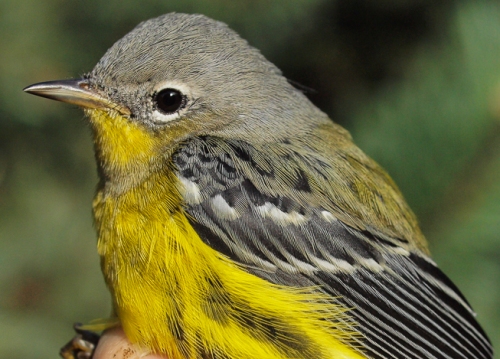
There was no doubt that this was the week of Magnolia Warblers, with 84 of them
banded, including this after-hatch-year male.
(Photo by Simon Duval)
-
|
|
|
THIS WEEK |
THIS FALL |
2013 TOTAL |
SITE TOTAL |
|
# birds (and species) banded |
312 (40) |
1815 (64) |
3110 (86) |
44622 (113) |
|
# birds (and species) repeat |
72 (24) |
445 (37) |
775 (51) |
8756 (70) |
|
# birds (and species) return |
6 (4) |
34 (16) |
189 (35) |
1398 (38) |
|
# species observed |
91 |
130 |
163 |
208 |
|
# net hours |
479.5 |
3635.0 |
6991.8 |
76281.5 |
|
# birds banded / 100 net hours |
64.7 |
49.9 |
44.5 |
58.5 |
|
|
Note: table does not include nocturnal banding (owls) |
|
Banders-in-charge: Simon Duval, Gay Gruner
Assistants: Christine Barrie, Nicolas Bernier, Sue Bishop, Cindy Bouchard, Marie-France Boudreault, Rui de Jesus, Jean Demers, Geneviève Dubois, Kirsten Gavin, Nathalie Gendron, Monique Groulx, Alison Hackney, Lisa Keelty, Christie Lovatt, Barbara MacDuff, Marie Perkins, Catherine Russell, Ahmad Shah, Shawna Sevigny, Ahmad Shah, Clémence Soulard, Patricia Stotland, Elise Titman, Rodger Titman, Michael Waddes
THANK YOU!!! With the dedicated support of our many supporters, MBO placed a strong second in the Jamieson Vitamins "Call for the Wild" contest. On average, we received nearly 1000 votes per day, and we greatly appreciate everyone who made voting part of their daily routine for the past four weeks, and especially those who shared the contest with friends and family to extend our network. Thanks to your efforts, we have secured nearly $31,000 in funding for MBO, which will ensure we can not only maintain our programs in 2014, but also expand our research and education efforts - watch for more news over the coming months!
Notes: Week 7 is the midpoint of the fall season at MBO, and change was certainly in the air this week. Migration was very active this week, with the 312 birds banded only behind the 404 banded this week last year, and the 426 way back in our first full fall season in 2005. With that strong movement, the season total of 1815 remains ahead of the previous high at this point in fall, which was 1779 in 2010. Just as impressive though was the diversity of birds observed this week. The 91 species over the course of the week was the best ever for week 7, and the 63 species observed on September 14 was the highest ever single-day count at MBO in fall (the previous record of 62 also coming in week 7, on September 18, 2011). Between 51 and 56 species were observed on every other day except September 12, which was compromised by rain. Also, the 30 species banded on September 13 tied the record for any season, reached only once previously, on September 7, 2008 (in a remarkable coincidence, 81 individuals were banded on each occasion).
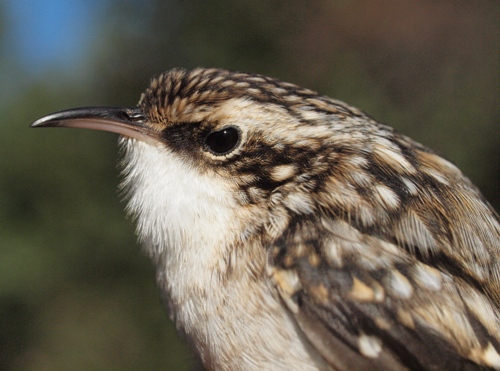
Brown Creepers and Golden-crowned Kinglets banded this week were signs of the advancing fall, with both being more typical of the second half of the season at MBO. The four Golden-crowned Kinglets caught at the same time was remarkable given that in most years none at all have been banded this early in fall.
(Photos by Simon Duval)

|
Coming into week 7, the 122 species observed to date this fall was already more than in any previous year - and yet this week we managed to add another 8 species to the list! The biggest surprise was a Blue-gray Gnatcatcher, only the third ever observed at MBO (previous records occurring in May 2008 and August 2012). Also of note was our fourth Clay-colored Sparrow, with previous ones in August 2007, September 2009, and October 2011. Contributing to our fall single-day record of 63 species on September 14 were our first American Kestrel and Herring Gull of the season. This week's other new arrivals were Wilson's Snipe, Brown Creeper, Field Sparrow (our first of 2013), and Rusty Blackbird. Species banded for the first time this fall were Brown Creeper and Common Grackle.
This week’s top 10 [last week's rank in brackets]
# individuals banded |
mean # individuals observed daily |
1. Magnolia Warbler (84) [1] |
1. Common Grackle (80) [-] |
2. Tennessee Warbler (17) [2] |
2. American Crow (76) [1] |
3. White-throated Sparrow (15) [-] |
3. European Starling (75) [8] |
4. Cape May Warbler (14) [-] |
4. Canada Goose (53) [9] |
5. Red-eyed Vireo (13) [9] |
5. Red-winged Blackbird (33) [5] |
6. Swainson's Thrush (12) [-] |
6. American Goldfinch (26) [2] |
6. American Redstart (12) [3] |
7. Cedar Waxwing (20) [3] |
6. American Goldfinch (12) [4] |
8. Blue Jay (19) [7] |
9. Nashville Warbler (8) [-] |
9. Magnolia Warbler (18) [6] |
10. Golden-crowned Kinglet (7) [-]
10. Black-throated Blue Warbler (7) [-]
10. Song Sparrow (7) [-]
|
10. Black-capped Chickadee (15) [4]
|
|
It has been a while since one species dominated as thoroughly as Magnolia Warbler did this week, with nearly five times as many banded as the runner-up. Historically, Magnolia Warbler numbers were tapering off by week 7, but this is the third time in the past four years that they have topped the list at this time of year, suggesting that the peak of their migration is shifting a bit later. The season total for Magnolia Warbler now stands at 260 individuals banded, just barely below the record of 264 set in 2008, which is sure to fall early in week 8. Although Tennessee Warbler numbers are now dropping quickly, they clung to second place for another week, and extended their record high fall total to 225, which is also second only to Magnolia Warbler for fall 2013 so far. Overall, only five of last week's top ten made the list again this week, reflecting that there was quite a bit of mid-season change at MBO this week after a few weeks of relatively similar results. White-throated Sparrows finally started to arrive, with just enough to claim third place, although fewer than the long-term average of 23 banded in week 7. Most remarkable were another 14 Cape May Warblers - more in a single week than any previous full year except 2011, and pushing the fall 2013 total to 43 individuals, more than double the previous record of 19 in 2011. Looking at it a different way, we have banded as many Cape May Warblers over the first seven weeks of this fall as we did in total from 2005 through 2012! Red-eyed Vireos rebounded a bit from last week's dip in numbers to claim fifth place. There was a three-way tie for sixth, with American Redstarts starting to taper off, Swainson's Thrushes starting to arrive, and American Goldfinch holding close to steady from last week. Nashville Warblers have been unusually scarce this fall, and although they squeaked into the top ten this week, the 8 individuals is well below the week 7 average of 19. In the three-way tie for tenth place, the big surprise was Golden-crowned Kinglet, which in six of eight previous years hasn't been banded at all until week 8.
Among species observed this week, the changes were more subtle, with all but one of last week's top ten still on the list this week. The big change was right at the top, where Common Grackle came from nowhere thanks to the arrival of the first late fall mixed blackbird flocks (which also accounted for the top-five showing of European Starling and Red-winged Blackbird). The top three were unusually closely clustered this week, with American Crow sandwiched in between grackles and starlings. Continuing the theme of flocking species, Canada Goose numbers are also growing noticeably. American Goldfinch and Cedar Waxwing were each bumped down four spots this week, largely due to the increase in those other species' flocks. Blue Jay finally dropped one spot this week although the mean number observed daily actually increased; similarly Magnolia Warbler fell down the list even though the actual count rose compared to last week. Our resident Black-capped Chickadees were just barely numerous enough to cling to the bottom of this week's top ten.
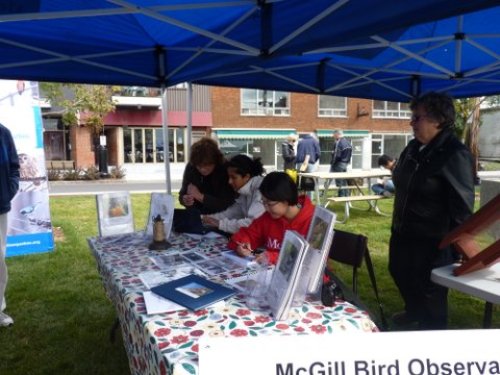
Thanks to Jean Demers, Alison Hackney, Ana Morales, Clémence Soulard, and Yifu Wang for sharing MBO with the public at Ste-Anne-de-Bellevue's annual Ecology Day on September 15.
(Photo by Jean Demers)
|
We are now past the halfway point of fall 2013! It has already been a terrific season with respect to volume and diversity of migrants, engagement of volunteers, and fundraising for the future. Thank you again to all who have already contributed this season, and we look forward to even more success over the final six weeks of fall, which traditionally is our busiest time of year.
|
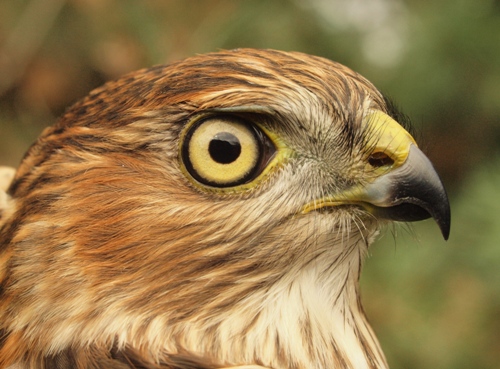
One of the two Sharp-shinned Hawks banded this week.
(Photo by Simon Duval)
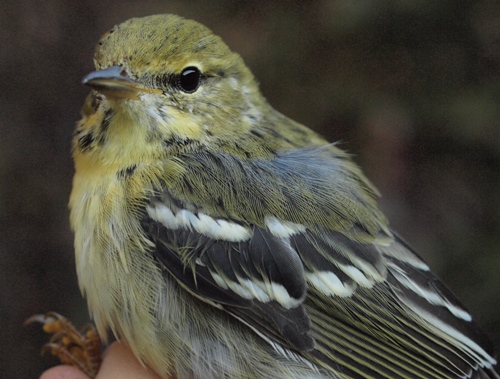
One of the less striking warblers in fall, Blackpoll Warblers can cause some identification challenges, but the orange feet are a good clue.
(Photo by Gay Gruner)
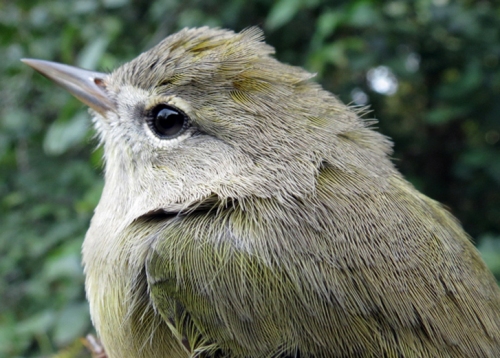
Another relatively drab fall warbler is this Orange-crowned Warbler (with just a hint of orange visible in this case).
(Photo by Gay Gruner)
|







